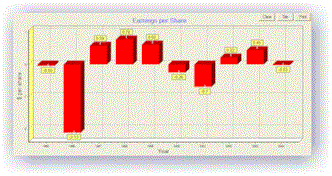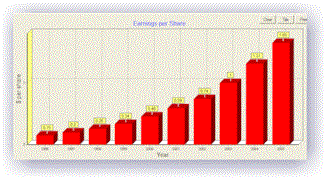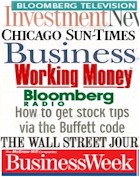| Conscious Investor contains
many layers of proprietary tools. The good news is that
due to the hours of work by Professor John Price and the
Conscious Investor team, it is really your choice how much
you want to know about them.
Conscious Investor is like a chauffeur-driven
limousine where the chauffeur knows all about the underlying
features. All you need to do is tell the driver where to go
and everything that is needed is called into action.
Simply put, the Conscious Investor software
and database is like helping you find a needle in a haystack
without all the work.
But for those who want to know more about the
technical details, here are brief descriptions of some of
these proprietary tools and why they are included in Conscious
Investor. We list them in alphabetical order: HGROWTH™,
STAEGR®, STRET™, STRETD® TARG™, and TARGD®.
HGROWTH
HGROWTH is the name of the function that calculates
the average annual growth rate of a sequence of historical
data. It differs from the standard method since it takes into
account all the data and not just the first
and last terms. Other features that make it unique
STAEGR
STAEGR is the function that measures the stability
or smoothness of the growth in earnings and sales. It is the
partner to HGROWTH. HGROWTH measures how fast earnings or
sales are growing or decreasing while STAEGR measures how
smoothly this is taking place. It is pronounced “stay-gar”.
We invest in bonds and and other fixed instruments
because of the certainty of the outcome. STAEGR is a tool
that helps to bring that certainty into the stock market.
Example
of a Low Stability Stock
 |
Example
of a High Stability Stock
 |
Conscious Investor helps you choose
companies with growth and stability like those on
the right. |
STRET/STRETD
The most important question we can ask as investors
is what return can I expect on my investment under my margin
of safety. This is where STRET and STRETD enter. STRET is
a calculation of the average annual percentage profit or rate
of return from owning the stock.
It is assumed that when the dividends are received,
they are taxed. The remaining funds are then invested for
the remainder of the holding period. The annual interest on
this re-investment is also taxed at the dividend tax rate.
STRETD is the same as STRET except that it is
assumed that the dividends are reinvested by purchasing more
shares in the company.
You can remember the name STRET by thinking
of "STock RETurn".
TARG/TARGD
Sometimes the calculation of the stock return
at the current price as calculated by STRET is too low. TARG
calculates what price you would need to pay to get your desired
return on any stock that you are considering under your margin
of safety.
TARGD is similar except that it is assumed that
dividends are to be reinvested. Together these two functions
fulfil he statement by Warren Buffett that he is willing to
wait indefinitely to buy the stock he wants at the price that
he is willing to pay. TARG and TARGD help each investor to
calculate that target price.
When this is done, investing is much more enjoyable
because now you look forward to the volatility since he may
give you that opportunity to buy (or sell) at your target
price. [ More details ]
Automatic Margin of Safety
Most people buy shares with the hope of the price rising. If this happens in a sufficiently short period of time, they get a reasonable return. But if the price does not rise at all, or if the rise is very slow, then it would have been better not to have purchased shares to begin with.
The problem is that this approach is back to front.
Instead of hoping for a reasonable return, Conscious Investor starts with the goal of calculating the return under a margin of safety. In other words, we start by asking and answering the question:
What rate of return can be expected at the current price under a margin of safety?
Answering this question is followed by considering whether this return is high enough and secure enough to meet our investment needs.
Although many analysts talk about margins of safety, they tend to be applied too late in the investment process. They usually calculate intrinsic value and then ask if the company is trading at a low price compared to its intrinsic value. Apart from the instability of intrinsic value calculations described earlier, another problem is that the method fails to distinguish between the safety requirements of different components in any valuation calculation.
Conscious Investor overcomes these problems by using methods based on the procedures developed by engineers and architects. Using computer models, they stress test designs for bridges and buildings before starting construction to ensure their safety under extreme conditions or scenarios.
Similarly, through proprietary tools in Conscious Investor, margins of safety are used to stress test potential investments before any purchases are made. Objective computer procedures automatically identify weaknesses in the financial data of a company that may not be discernible by simply reading the financial statements and company reports. Such weaknesses are then used to strengthen the safety requirements. This testing is carried out in the three areas of business growth, market opinion and the board dividend policy.
It needs to be emphasised that these margins of safety are the result of testing thousands of companies over many years to ensure that safety is paramount. Even so, because of extra information, at times the investment committee may decide to impose even stronger margins of safety.
Returning to the earlier question, if we bought shares in the company at the current price, proprietary calculations within Conscious Investor show how to answer the question by calculating the return that can be expected. Furthermore, as explained, confidence in these calculations is supported by stress testing. The return calculation also includes both capital gains and dividends.
Again we emphasize that, since these tools are
combined in such a coherent way and since they are all supported
by systematic training and support programs, everything is
surprisingly effortless.
|





